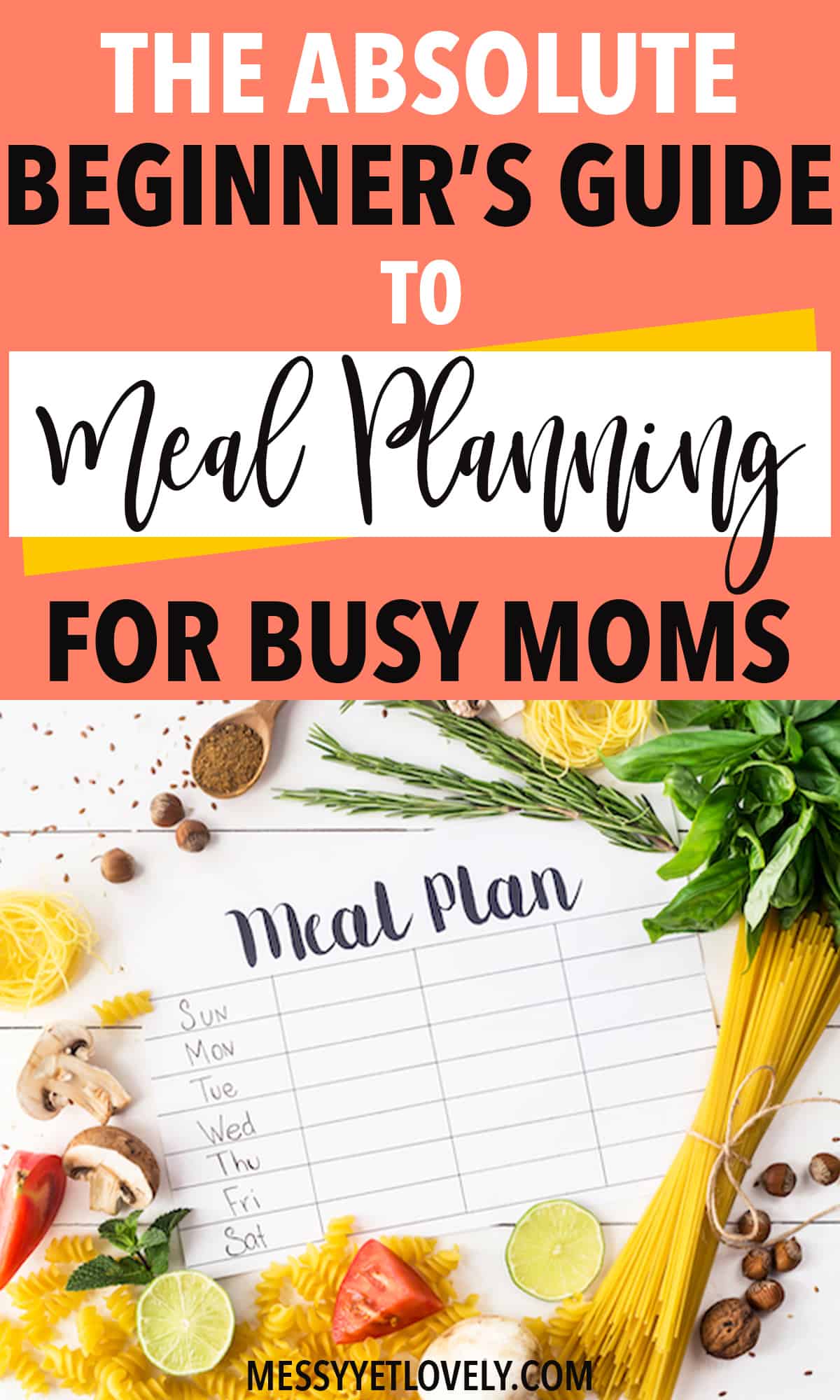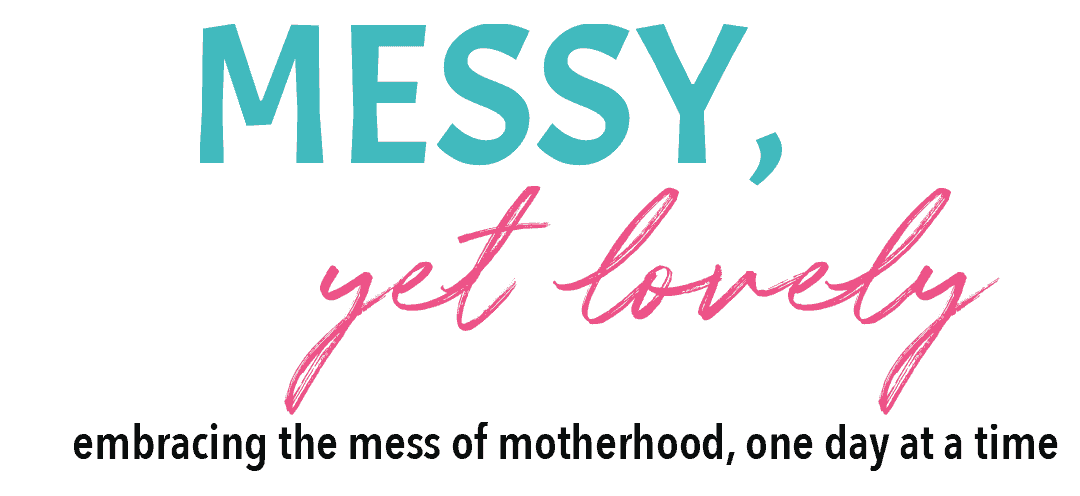Like every mom, you wish to make healthy homemade meals for your family.
Cooking at home means, making a lot of decisions. Though it might seem like a silly thing to plan your meals, the benefits are many.
Do you face the dreaded questions like,
“Mom, what’s for dinner today?”
Or do you find asking questions to yourself like,
Should I make a vegetarian dish or chicken? Pasta or Rice?
So many questions that can push you into analysis paralysis and waste your precious energy (thinking does require energy).
That’s where meal prep or meal planning can save your life. In this beginner’s guide to meal planning for moms, you will learn all the essentials to get started with meal planning.
You don’t need to be a great cook to do meal planning. Meal planning is for everyone and the intention is to reduce the overwhelm that moms face with all the other household chores. Especially if you are a working mom, meal planning can be a lifesaver.
WHAT IS MEAL PLANNING?
Meal planning is the planning ahead of meals and scheduling them so as to avoid the overwhelm of decision making.
Meal planning consists of at least 5 parts which are
- Deciding
- Scheduling
- Buying the groceries
- Meal prepping
- Heating or cooking the food
WHY SHOULD YOU DO MEAL PLANNING?
Okay, that’s all great! Now if you are wondering how meal planning can help you, let me talk about the benefits of meal planning.
MEAL PLANNING SAVES TIME
When you already know which dish you are gonna make on a Thursday afternoon, you can be calm and relaxed on that day because there is no time spent on indecision.
Meal planning requires you to purchase the ingredients needed to make a meal in advance.
How many times has it occurred to you that you open the pantry and find that the ingredients you want are missing?
You are frustrated and now you need to go for grocery shopping. Or wait till the delivery man gets it to your home. You lose your time either way.
Now, imagine you open your pantry and see that you have all the right ingredients there. You can start cooking right away. And since you have done the meal prepping (more on it later) part, more time can be saved.

MEAL PLANNING DECREASES STRESS
The indecision of what to make and the frustration of not having enough ingredients can put you under stress. You may not feel it as a big tension, but small things add up.
As a mom, you have to juggle so many things daily. Like, preparing food on time for the whole family, other chores like cleaning, listen to your kids’ whining and refereeing between their fighting, dealing with big emotions and complaints, the list goes on.
All the little stressful things add up as the day progresses. And our goal here is to reduce the stress and overwhelm of a mom, as much as we can.
You don’t want the stress of cooking to spill as yelling at your daughter when she acts a little mischievous. So when the stress level is down in one area, you are happier and calmer.
What happens when you have a meal plan handy?
You can refer to your plan each morning, take the prepped meals from the freezer and is ready to go.
You have already done the thinking part, now you can get to the action part. You are in more control of your schedule. There are no surprises, therefore you are more peaceful and calm.
MEAL PLANNING SAVES MONEY
When you have a meal plan and you go to the grocery store, you have the list of items you want handy and therefore you can avoid impulse purchases and save money.
You don’t buy unnecessary ingredients that you think you will use this week but do not and throw away later because you didn’t get a chance to use it.

MEAL PLANNING LETS YOU MAKE A VARIETY OF FOOD
I have often felt bad about sending the same snacks over and over again for kids to school. By the end of the school year, they are tired of eating the same food again and again. I do not do it deliberately, but what happens is, when you don’t have a plan, you reach for the easiest snack that’s available in front of you. And same is the case with any meal that we prepare.
We need to eat a balanced and nutritious diet. So, when you do meal planning, you get the chance to plan meals by including all the veggies, fruits and meat in a week.
And it also helps to break the boredom of eating the same food every other day.
HOW TO GET STARTED WITH MEAL PLANNING?
As a beginner mom to meal planning, you may find it confusing and may feel like you don’t know where to start. But don’t worry, let’s see how to get started step-by-step.
1. DECIDING
The first step is thinking about how far along you should schedule your meals. Is it for a week, a fortnight or a month?
Personally, I like to plan for a fortnight. Since you are a beginner, you can also start with weekly or fortnightly planning.
But if you are too busy or have so many appointments in a month, you can try monthly meal planning because you will be listing out the activities in a month in your calendar. And work your meal planning around that.
MAKE A MASTER LIST
Make a master list of meals that your family loves. Include every dish that your family loves. Ask them for their help while preparing the list and include their favorite meals.
The idea is to refer to this list whenever you have no idea about what to make. It is also quite possible that you forget about some dishes for a long time. So making this list helps as a fallback.
And also, don’t forget to keep adding the new favorites to this list.
When making the recipe bank, think ahead about all kinds of days. For the days you don’t have much time, you need recipes for quick meals. And on days you have more time in the morning, you can cook a slow-cooker recipe.
And also have meal ideas for each season. Like soups and stews for winter and salads and berries for summer. I like saving new recipe ideas onto my Pinterest boards. If a recipe is a hit, I add them to my recipe list.
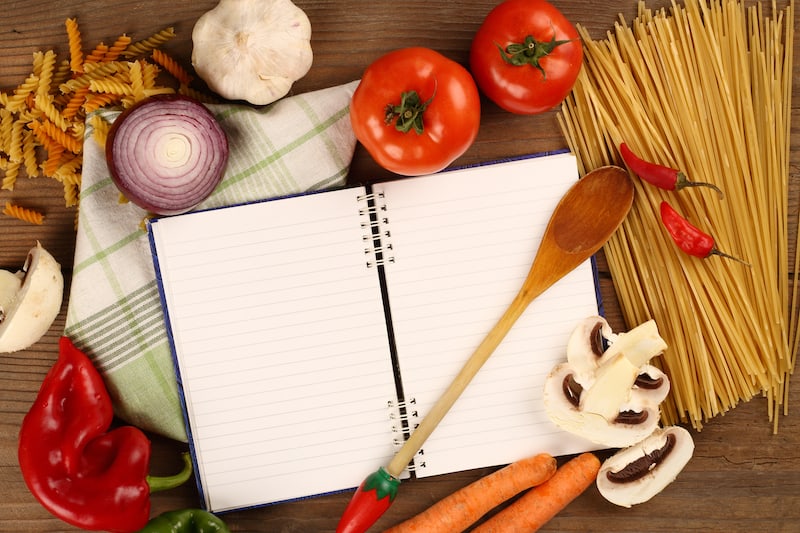
2. START WRITING ON YOUR CALENDAR
Some like digital calendars while some others can’t let go of the traditional pen and paper planners.
I am a pen and paper planner person and prefer paper planners only. But you can use any of your favorite scheduling tools.
Options for digital calendars include Google calendar, Apple calendar (for Apple devices), Cozi Family Organizer, etc.
Cozi app lets you save recipes in one place and add the ingredients to your grocery list with just one touch. And it’s an app that the whole family can use, so everyone knows what they will be eating next.
For analog planning, you can use a printable meal planner or a bullet journal. Another great idea is to print and laminate the meal planner and use a whiteboard marker to write on it.
You can keep this in your kitchen so that you can refer to it easily. Another benefit is you can reuse the same printable page again and again by rubbing the writing on it.
Now start writing on the calendar. If there are any events on any day, write it in advance since you don’t need to cook that meal.
And start writing the corresponding meals in each box. It’s better to write with a pencil, because on some days some other plans may come up. Or you might have some leftovers which you can have on the next day.
A meal plan is not set in stone. You can change the plans and allow room for flexibility. Just because you wrote it down doesn’t mean you have to follow it. The idea is to reduce stress and be prepared. At the same time, be flexible to change the plans around.
I am not sure where I got this idea first from, but I heard having a theme for each day works for many people. Like pasta on Mondays, soups on Tuesdays, muffins on Wednesdays and so on.
You can quickly refer to the recipe list and plan the meals. This will make meal planning even quicker. And it is more helpful for meal planning beginners. You can use the theme idea as you get more used to meal planning.
3. SHOPPING FOR GROCERIES
Next comes shopping. Remember, by buying groceries for a week or a month, your aim is to reduce the trips to the grocery store thereby saving time and money.

So before leaving home, refer to the meal plan and make the grocery list. Check your pantry and refrigerator thoroughly if you already have the ingredients.
I have made the mistake and came home with the same packet of cornflour (rolling eyes..) again.
Now that you have the plan and the ingredients, let’s do meal prepping.
4. MEAL PREPPING
Meal prepping means scheduling a time block to batch cook the ingredients or prepare full meals in advance and freeze them as batches so that you can use them later in the week.
The benefit of meal prepping over buying store-bought frozen food is since you cook it yourself you know what ingredients go into it. There are no unhealthy processed ingredients or preservatives.
It is an investment of your time for better health for your family.
When it comes to meal prepping, you don’t have to prep for each meal of the day unless you want to.
For example, I don’t struggle with breakfasts much. What I struggle with is dinner. So for me, it’s always a good idea to prep the ingredients for dinner or batch cook meals. Later, I simply have to thaw the meal and heat it.
And I also struggle with kids’ snacks for school recess, so I prep the veggies ahead for the week.
So, since you are a beginner to meal planning and prepping, do not attempt to do it all at once. Start slowly and examine the area where you struggle with.
Start meal prepping for lunch if you struggle with that or if mornings are hectic for you, try batch cooking steel-cut oats for a week.
I hope you get the idea.
Choose the day for meal prepping. You can do meal prepping whenever you get time. But many people like to do it on a Sunday since they are off work and they can use the help of their spouse and kids.
Meal prepping helps you to prepare meals quickly because you already have cooked ingredients or cut veggies and fruits or even fully cooked meals.
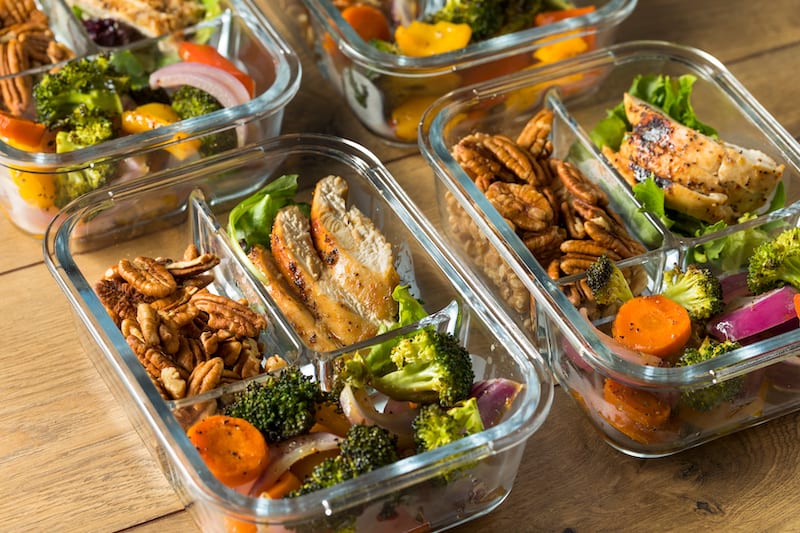
WHICH CONTAINERS SHOULD YOU USE FOR MEAL PREPPING?
Do you need new containers for meal prepping?
Depends upon what you have right now. If you have plastic containers, it’s doubtful whether they can keep your food fresh for long without any smell leaching onto it. Plus, you have to think about all the chemicals that can leach into the food while reheating.
Therefore, experts recommend glass containers to make it safer for reheating and storing food without losing the freshness. There are glass containers available in the market which are claimed to be safe for microwave, oven, freezer, and dishwasher.
Other healthy options are steel and silicone containers.
I always try to reduce the use of plastic. but, if you think plastic containers are more convenient for you, look for the ones that are BPA free.
Now let’s see how you can do meal prepping for a week for each type of food.
FRUITS AND VEGGIES:
If you want to get your toes dipped with meal prepping, starting with fruits and veggies is a good idea.
We all know that we need to include more fruits and veggies in our diet. But if you are tired after work, there are more chances of grabbing that packet of junk food instead of preparing healthy snacks. That’s where meal prepping can help you.
After washing, store fruits and veggies in the refrigerator after cutting or cooking them. Grab them later when you need it. That’s it. Easy-peasy!
Dry them with a paper towel before storing. If you buy fruits and veggies in bulk, you can store them in the freezer in separate bags so as to retain the freshness and the nutritional value.
If you have cut fruits ready you can use it in your smoothies or oatmeals as breakfast, pack it as school snacks for kids, or have it as an evening snack.
It is easier to grab a carrot stick or a vegetable salad after work as a snack, or add them to your meals if you have cut or cooked them.
Fruits and veggies remain fresh for about 3 – 5 days.
MEAT
You can prep meat by cooking and storing it in the refrigerator or in the freezer depending upon when you will use it.
You can store meat in the refrigerator for 3 to 4 days and in the freezer for months depending upon how you cook it. Here is a chart from foodsafety.gov on storage times for meat and meat products. Check it out, it’s a great resource.
Personally, I don’t prefer to keep any food in the freezer for more than a month.

Tips for meal prepping meat
- If you are making curries, you can make the curry itself and portion it. Keep the portion that you are going to use this week in the refrigerator. And store the rest in the freezer.
Or
Just cook the pieces and store them. Thaw it later when you want to make the curry. This helps to quicken the time required for cooking.
- If you want to prepare a healthy salad for the week ahead, cook the veggies and chicken. Then, portion it by keeping them in different containers of the same size, so that it’s easier to stack them up in the refrigerator. Reheat before having it and your healthy meal is ready in minutes.
- If you are simply cooking the meat pieces, store them in different containers or in zip-loc silicone bags, measuring the amount that your recipe calls for.So that later when you make the recipe, you need to thaw only what you need.
- Use smaller containers to store as portions to avoid having extra air in the container. And it also helps in quicker cooling of each portion.
GRAINS
Grain bowls are my absolute favorite meal to have. They are high in protein, have more than one veggies, colorful and flavourful.
They are filling and keeps you satiated.
As a beginner to meal planning, you can start experimenting with grain bowls. Cook a batch of grains (rice, quinoa, millet, etc), prep your veggies and meat over the weekend. Reheat them and assemble everything before serving.
Or you can make the bowls ahead for the week and store them. Also, use your best judgment on the number of days you want to keep it in the fridge. I wouldn’t go past 3-4 days so as to retain the freshness.
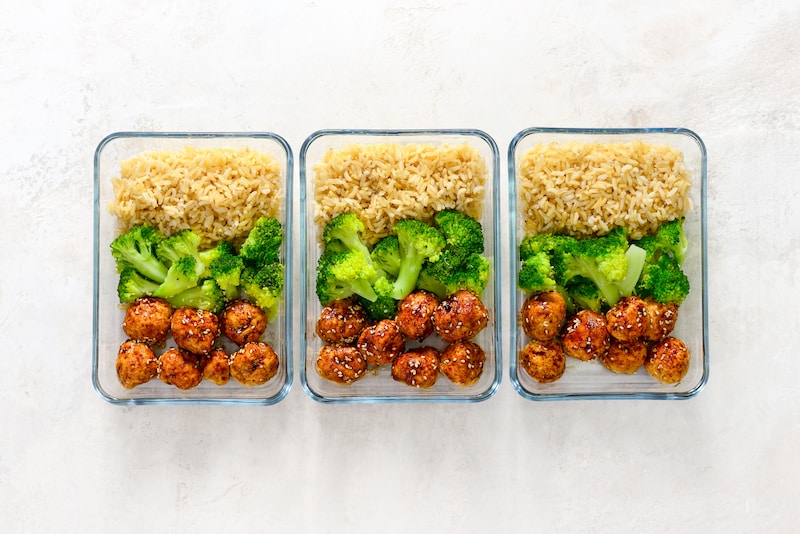
BEGINNER TIPS FOR MEAL PREPPING
- Use the same ingredients in different recipes each week.
While meal planning, try to schedule recipes with the same ingredients in a week. This helps in using up the prepped ingredients sooner than later. And you save more time in meal prepping because each of your recipes does not require entirely different ingredients in a given week.
- Storing food in zip loc
When storing food in zip-loc bags, squeeze out the extra air so as to keep it airtight and fresh for long.
- Cool the food as soon as possible
You need to store the food properly or else your hard work could go waste. If the food is cooled down while it’s still fresh, it can retain the freshness for long in the refrigerator. Therefore, bring the temperature of the food down within 2 hours of cooking and store it quickly.
- Label
If you are going to freeze it for long, it is helpful to label the container with the date. Use a sticker or a masking tape and a permanent marker.
I think that’s enough information to get started with meal prepping.
Now let’s move onto the next part, which is,
5. HEATING OR COOKING THE FOOD
You have prepped the ingredients. Next, you have to get the food ready on the table for each meal. Let’s see the general guidelines for heating and thawing.
Thawing/ defrosting
To defrost food, experts recommend that you should always defrost food in the fridge for a number of hours before cooking or eating. If you are short on time, you can defrost using a microwave. But keeping the food outside in the room temperature to thaw is a bad idea as it could contaminate the food.
And finally, there are food items that you should never put in the freezer. Keep them in the refrigerator and only cook as much quantity that would not get spoiled in a week.
Reheating food multiple times causes the quality of food to decline. Therefore, reheat only what is required. That’s why storing in portions is advised, so that you need to thaw and reheat only what you need.
So now you know how to start meal planning. Say goodbye to the overwhelm and the troubles of cooking each meal from scratch every day. Start small and remember to stay flexible with your plan when needed.
Do you have any tips to offer for meal planning? Do let me know in the comments!
If you love what you are reading, please take a moment to PIN and SHARE!
